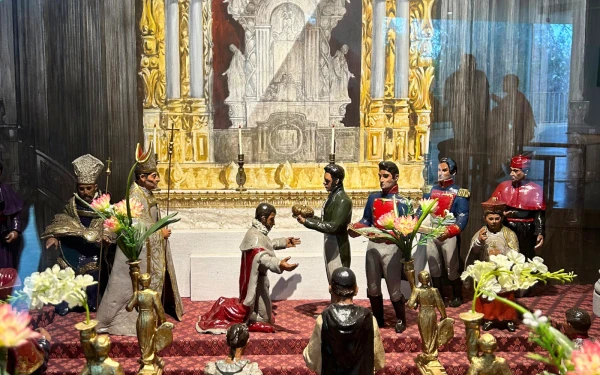The remains of Agustín Cosme Damián de Iturbide y Arámburu, hero who achieved the Independence of Mexico, rest in the Metropolitan Cathedral of Mexico City. Although his figure has been relegated in the official narrative, his legacy is still present in this iconic religious venue.
The Mexican War of Independence, which began on September 16, 1810 with the “Cry of Dolores” by P. Miguel Hidalgo, culminated on a day like today, September 27, 1821, with the triumphal entry of the Trigarante Army into the City. of Mexico, under the command of Iturbide.
Receive the main news from ACI Prensa by WhatsApp and Telegram
It is increasingly difficult to see Catholic news on social media. Subscribe to our free channels today:
The name of the Trigarante Army referred to the three guarantees or fundamental principles that it demanded: the defense of the Catholic faith as the official religion, the independence of Mexico and the union between Europeans and Americans.
These three guarantees also inspired the colors of the Trigarante Army flag, the same as the current Mexican flag.
In 1822, Agustín de Iturbide was crowned the first emperor of Mexico in the Metropolitan Cathedral, where his remains rest today.

In 1823, Agustín de Iturbide abdicated the throne of Mexico and went into exile abroad. During his stay, he learned of an alleged attempt to reconquer the former viceregal territory, which led him to return to Mexico in May 1824 to warn of possible European intervention.
However, he was unaware that he had been declared a traitor. He was arrested and shot in Padilla, Tamaulipas, on July 19, 1824. Later his remains were transferred to the Metropolitan Cathedral.
Preserved in a glass urn in a corner of the chapel dedicated to San Felipe de Jesús, the first Mexican saint, are the skull and bone structure of Agustín de Iturbide. Next to them, a trigarant flag and his throne accompany the remains, while a commemorative plaque honors his legacy with the following words:
Agustín de Iturbide
Author of Mexican Independence
Countryman cry it out
Passenger admire it
This monument keeps the ashes of a hero
His soul rests in the bosom of God
Unlike other heroes of Independence, whose remains were transferred to the Angel of Independence in 1925, Iturbide remained in the Cathedral of Mexico.
Iturbide a hero in the “penumbra, in the shadow”
The figure of Agustín de Iturbide has faded from the official memory of Mexico. As an example, in 1921 his name was removed of the Wall of Honor that lists national heroes in the session hall of the Chamber of Deputies of the Congress of the Union, the federal legislative body of Mexico. Furthermore, in 1943, by presidential decreetwo stanzas of the National Anthem that mentioned Iturbide were deleted.
Dr. Jesús Joel Peña Espinosa, researcher at the National Institute of Anthropology and History (INAH), told ACI Prensa that the figure of Iturbide “has been displaced from his rightful place in the historical narrative.”
Peña Espinosa, also a Master in Church History from the Pontifical University of Mexico (UP), explained that history has been used “for the construction of political discourse, for the legitimation of regimes of any sense and of any color, to “the construction or rather the underpinning of state projects, of nation projects.”
According to the researcher, in Mexico there is “a very great liberal tradition in the construction of Mexican historiography,” whose bias “has been imprinted on the results and in the promotion, in the dissemination of history.” In this way, he noted, Iturbide has been left “in the shadows, in the shadows, and the role he played has been hidden from him.”
“The identity of contemporary Mexico” and the Catholic faith
Peña Espinosa indicated that the “religious matrix” of the society of Iturbide’s time “was Catholicism,” and the hero of Independence understood that it was not possible to imagine the transformation of the nation “without starting from these bases.”
In this sense, the researcher explained that for Iturbide, faith was fundamental, both in his “personal conviction” and because of his “clarity of belonging to a Catholic group.”
Peña Espinosa stated that “the identity of contemporary Mexico is unthinkable without the role played by Catholicism, and by Catholicism understood (both) in the hierarchical structure and in the people.”
The INAH researcher reiterated that “the imprint of Catholicism in the construction of the identity of mestizo and multicultural Mexico” was “undeniable.”

